Microparticle Transport and Sedimentation in a Rhythmically Expanding Alveolar Chip
Abstract
1. Introduction
2. Materials and Methods
2.1. Experimental System
2.2. Flow Visualization
2.3. Dynamic Similarity of Particle Transport
3. Results and Discussion
3.1. Alveolar Chip Placed Horizontally
3.2. Alveolar Chip Placed Vertically
3.2.1. Instantaneous Flow Patterns in Alveoli
3.2.2. Particle Tracking in Alveoli at Different Generations
3.3. Effects of Particle Size on Sedimentation
4. Conclusions
Author Contributions
Funding
Institutional Review Board Statement
Informed Consent Statement
Data Availability Statement
Conflicts of Interest
References
- Chen, R.; Hu, B.; Liu, Y.; Xu, J.; Yang, G.; Xu, D.; Chen, C. Beyond PM2.5: The role of ultrafine particles on adverse health effects of air pollution. Biochim. Biophys. Acta 2016, 1860, 2844–2855. [Google Scholar] [CrossRef] [PubMed]
- Hogan, B.; Tata, P.R. Cellular organization and biology of the respiratory system. Nat. Cell Biol. 2019. [Google Scholar] [CrossRef]
- Kim, K.H.; Kabir, E.; Kabir, S. A review on the human health impact of airborne particulate matter. Environ. Int. 2015, 74, 136–143. [Google Scholar] [CrossRef]
- Dong, J.; Yang, Y.; Microfluidics, Y.Z.J. New insight into air flow distribution in alveoli based on air- and saline-filled lungs. Microfluid. Nanofluidics 2020, 24, 71. [Google Scholar] [CrossRef]
- Jung, D.J.; Shin, T.H.; Kim, M.; Sung, C.O.; Jang, S.J.; Jeong, G.S. A one-stop microfluidic-based lung cancer organoid culture platform for testing drug sensitivity. Lab Chip 2019, 19, 2854–2865. [Google Scholar] [CrossRef]
- Ghaemmaghami, A.M.; Hancock, M.J.; Harrington, H.; Kaji, H.; Khademhosseini, A. Biomimetic tissues on a chip for drug discovery. Drug Discov. Today 2012, 17, 173–181. [Google Scholar] [CrossRef] [PubMed]
- Huh, D.; Matthews, B.D.; Mammoto, A.; Montoya-Zavala, M.; Hong, Y.H.; Ingber, D.E.J.S. Reconstituting Organ-Level Lung Functions on a Chip. Science 2010, 328, 1662. [Google Scholar] [CrossRef]
- Tsuda, A.; Henry, F.S.; Butler, J.P. Gas and Aerosol Mixing in the Acinus. Respir. Physiol. Neurobiol. 2008, 163, 139–149. [Google Scholar] [CrossRef]
- Haber, S.; Yitzhak, D.; Tsuda, A. Gravitational deposition in a rhythmically expanding and contracting alveolus. J. Appl. Physiol. 2003, 95, 657. [Google Scholar] [CrossRef]
- Henry, F.S.; Laine-Pearson, F.E.; TsuDa, A. Hamiltonian chaos in a model alveolus. J. Biomech. Eng. 2009, 131, 011006. [Google Scholar] [CrossRef]
- Sznitman, J. Respiratory microflows in the pulmonary acinus. J. Biomech. 2013, 46, 284–298. [Google Scholar] [CrossRef] [PubMed]
- Hofemeier, P.; Sznitman, J. Role of alveolar topology on acinar flows and convective mixing. J. Biomech. Eng. 2014, 136, 061007. [Google Scholar] [CrossRef] [PubMed]
- Xi, J.; Talaat, M. Nanoparticle Deposition in Rhythmically Moving Acinar Models with Interalveolar Septal Apertures. Nanomaterials 2019, 9, 1126. [Google Scholar] [CrossRef]
- Kolanjiyil, A.V.; Kleinstreuer, C. Modeling Airflow and Particle Deposition in a Human Acinar Region. Comput. Math. Methods Med. 2019, 2019, 5952941. [Google Scholar] [CrossRef] [PubMed]
- Darquenne, C.; Harrington, L.; Prisk, G.K. Alveolar duct expansion greatly enhances aerosol deposition: A three-dimensional computational fluid dynamics study. Philos. Trans. A Math. Phys. Eng. Sci. 2009, 367, 2333–2346. [Google Scholar] [CrossRef]
- Ma, B.; Ruwet, V.; Corieri, P.; Theunissen, R.; Riethmuller, M.; Darquenne, C. CFD Simulation and Experimental Validation of Fluid Flow and Particle Transport in a Model of Alveolated Airways. J. Aerosol. Sci. 2009, 40, 403–414. [Google Scholar] [CrossRef]
- Oakes, J.M.; Day, S.; Weinstein, S.J.; Robinson, R.J. Flow Field Analysis in Expanding Healthy and Emphysematous Alveolar Models Using Particle Image Velocimetry. J. Biomech. Eng. 2010, 132, 021008. [Google Scholar] [CrossRef]
- Li, R.; Xu, X.-X.; Qiao, Y.; Zhao, X.-G. Experimental Research on the Impact of Alveolar Morphology on Deposition of Inhalable Particles in the Human Pulmonary Acinar Area. J. Med. Biol. Eng. 2018, 39, 470–479. [Google Scholar] [CrossRef]
- Fishler, R.; Mulligan, M.K.; Sznitman, J. Acinus-on-a-chip: A microfluidic platform for pulmonary acinar flows. J. Biomech. 2013, 46, 2817–2823. [Google Scholar] [CrossRef]
- Fishler, R.; Hofemeier, P.; Etzion, Y.; Dubowski, Y.; Sznitman, J. Particle dynamics and deposition in true-scale pulmonary acinar models. Sci. Rep. 2015, 5, 14071. [Google Scholar] [CrossRef]
- Fishler, R.; Sznitman, J. A Microfluidic Model of Biomimetically Breathing Pulmonary Acinar Airways. J. Vis. Exp. 2016, 111, e53588. [Google Scholar] [CrossRef] [PubMed]
- Fishler, R.; Ostrovski, Y.; Lu, C.Y.; Sznitman, J. Streamline crossing: An essential mechanism for aerosol dispersion in the pulmonary acinus. J. Biomech. 2017, 50, 222–227. [Google Scholar] [CrossRef] [PubMed][Green Version]
- Tippe, A.; Tsuda, A. Recirculating flow in an expanding alveolar model: Experimental evidence of flow-induced mixing of aerosols in the pulmonary acinus. J. Aerosol. Sci. 2000, 31, 979–986. [Google Scholar] [CrossRef]
- Tippe, A.; Perzl, M.; Li, W.; Schulz, H. Experimental analysis of flow calculations based on HRCT imaging of individual bifurcations. Respir. Physiol. 1999, 117, 181–191. [Google Scholar] [CrossRef]
- Li, R.; Xu, X.; Qiao, Y.; Zhao, X. Experimental research on the effect of functional residual capacity on the deposition of inhalable particles in human alveoli region. Sheng Wu Yi Xue Gong Cheng Xue Za Zhi 2018, 35, 557–563. [Google Scholar] [CrossRef]
- Chhabra, S.; Prasad, A.K. Flow and Particle Dispersion in Lung Acini: Effect of Geometric and Dynamic Parameters During Synchronous Ventilation. J. Fluids Eng. 2011, 133, 071001. [Google Scholar] [CrossRef]
- Tsuda, A.; Henry, F.S.; Butler, J.P. Chaotic mixing of alveolated duct flow in rhythmically expanding pulmonary acinus. J. Appl. Physiol. 1995, 79, 1055–1063. [Google Scholar] [CrossRef]
- Lv, H.; Dong, J.; Qiu, Y.; Yang, Y.; Zhu, Y. Microflow in a rhythmically expanding alveolar chip with dynamic similarity. Lab. Chip. 2020, 20, 2394–2402. [Google Scholar] [CrossRef]
- Tsuda, A.; Henry, F.S. Comment on “Microflow in a rhythmically expanding alveolar chip with dynamic similarity” by H. Lv, J. Dong, Y. Qiu, Y. Yang and Y. Zhu, Lab Chip, 2020, 20, 2394. Lab Chip 2021, 21, 1429–1430. [Google Scholar] [CrossRef]
- Lv, H.; Dong, J.; Yang, Y.; Zhu, Y. Reply to the ‘Comment on “Microflow in a rhythmically expanding alveolar chip with dynamic similarity”’ by A. Tsuda and F. S. Henry. Lab Chip 2021, 21, 1431–1432. [Google Scholar] [CrossRef]
- Dong, J.; Qiu, Y.; Lv, H.; Yang, Y.; Zhu, Y. Investigation on Microparticle Transport and Deposition Mechanics in Rhythmically Expanding Alveolar Chip. Micromachines 2021, 12, 184. [Google Scholar] [CrossRef] [PubMed]
- Tsuda, A.; Henry, F.S.; Butler, J.P. Particle transport and deposition: Basic physics of particle kinetics. Compr. Physiol. 2013, 3, 1437–1471. [Google Scholar] [CrossRef] [PubMed]
- Behera, S.N.; Betha, R.; Huang, X.; Balasubramanian, R. Characterization and estimation of human airway deposition of size-resolved particulate-bound trace elements during a recent haze episode in Southeast Asia. Environ. Sci. Pollut. Res. Int. 2015, 22, 4265–4280. [Google Scholar] [CrossRef] [PubMed]
- Daigle, C.C.; Chalupa, D.C.; Gibb, F.R.; Morrow, P.E.; Oberdorster, G.; Utell, M.J.; Frampton, M.W. Ultrafine particle deposition in humans during rest and exercise. Inhal. Toxicol. 2003, 15, 539–552. [Google Scholar] [CrossRef]
- Islam, M.S.; Saha, S.C.; Sauret, E.; Gemci, T.; Yang, I.A.; Gu, Y.T. Ultrafine particle transport and deposition in a large scale 17-generation lung model. J. Biomech. 2017, 64, 16–25. [Google Scholar] [CrossRef][Green Version]
- Liu, X.; Kong, S.; Yan, Q.; Liu, H.; Wang, W.; Chen, K.; Yin, Y.; Zheng, H.; Wu, J.; Qin, S.; et al. Size-segregated carbonaceous aerosols emission from typical vehicles and potential depositions in the human respiratory system. Environ. Pollut. 2020, 264, 114705. [Google Scholar] [CrossRef]

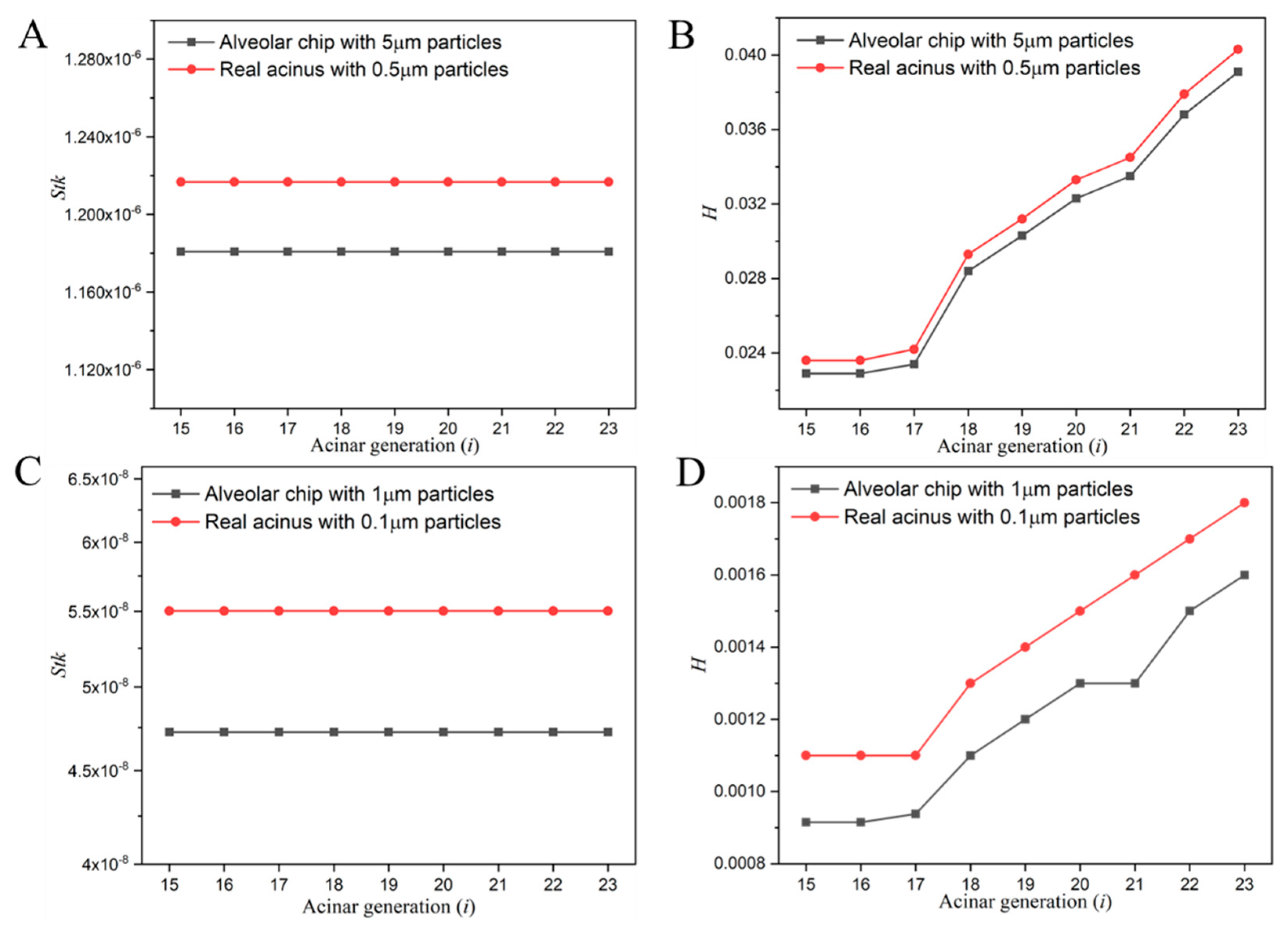
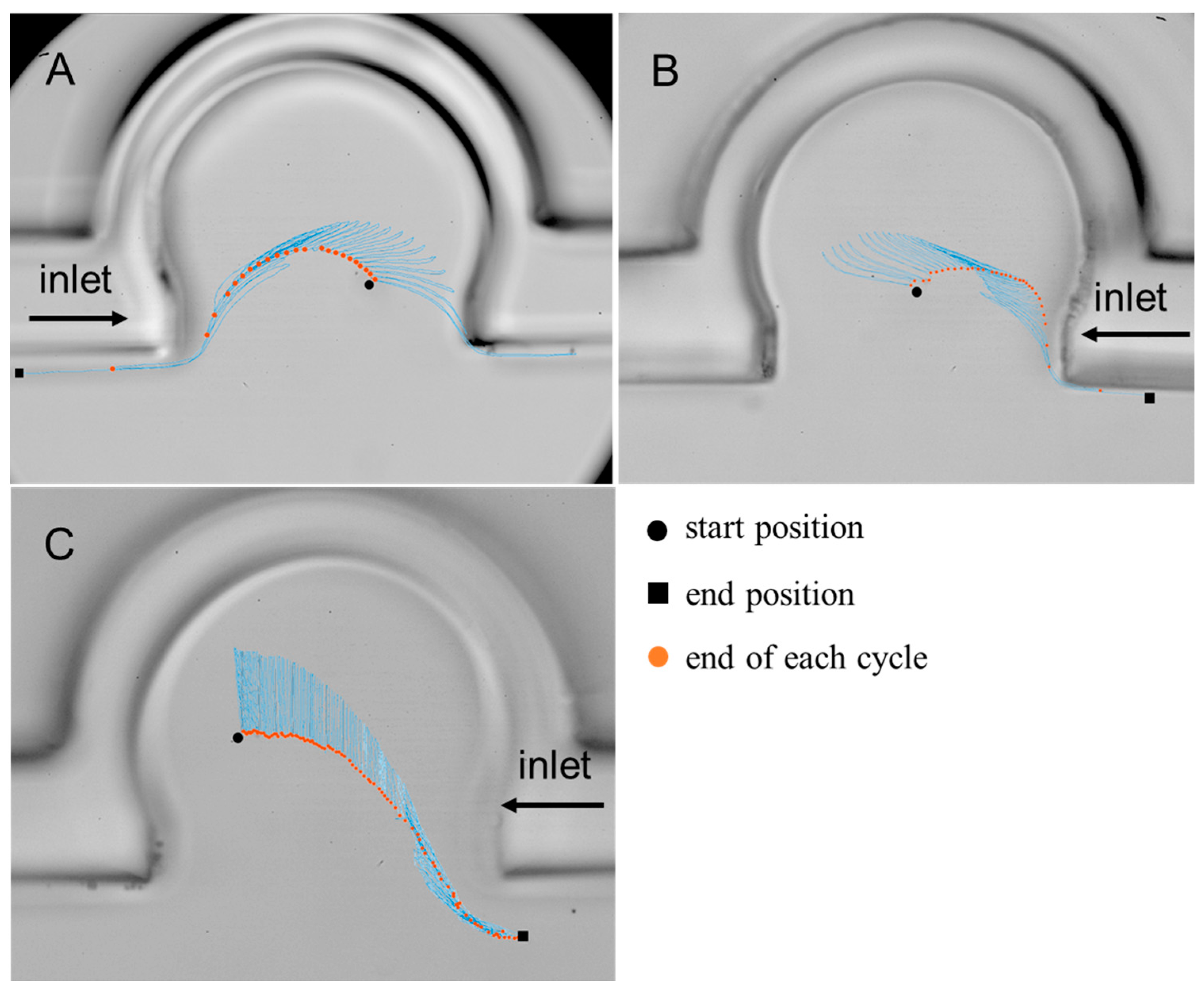
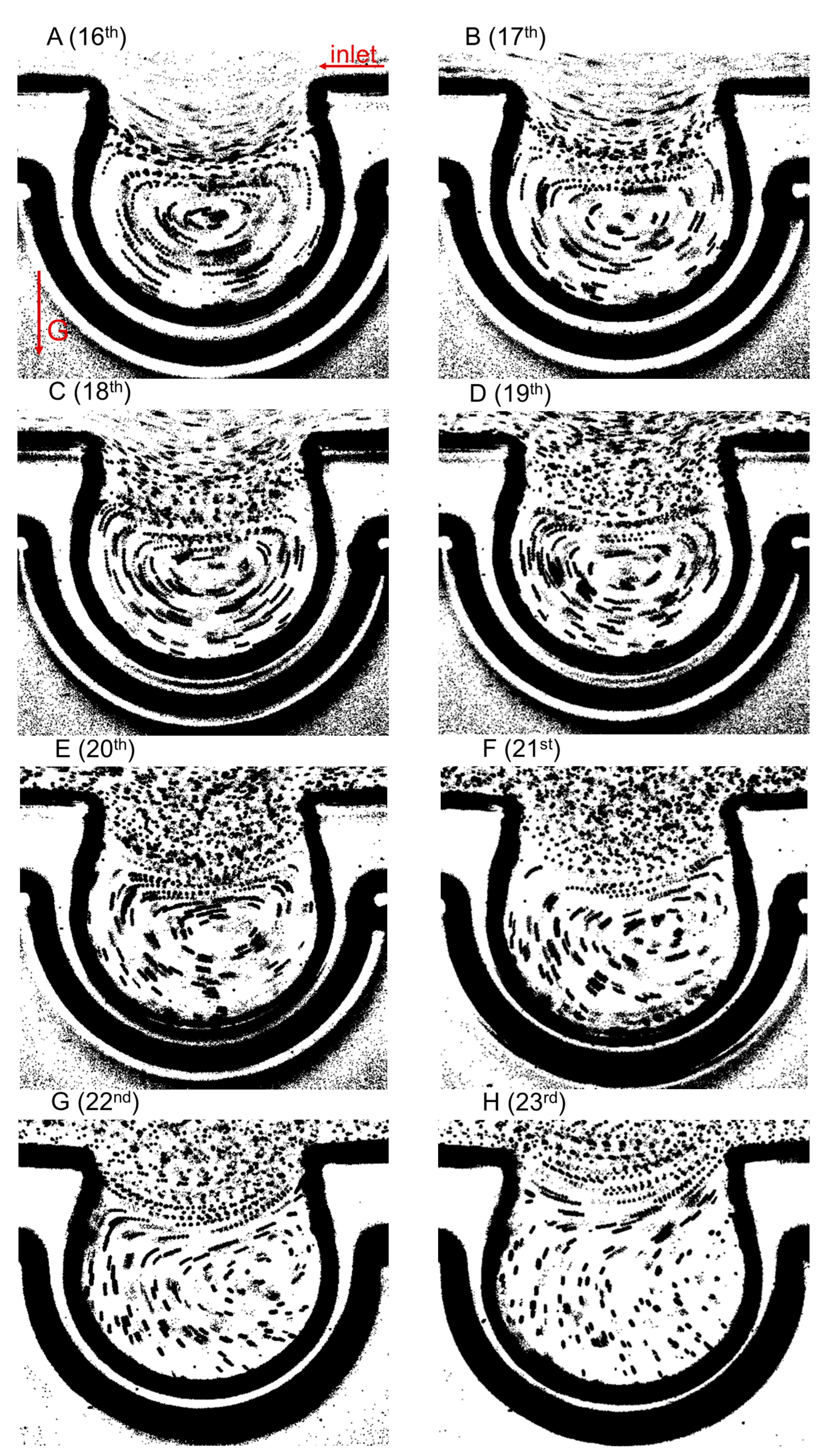
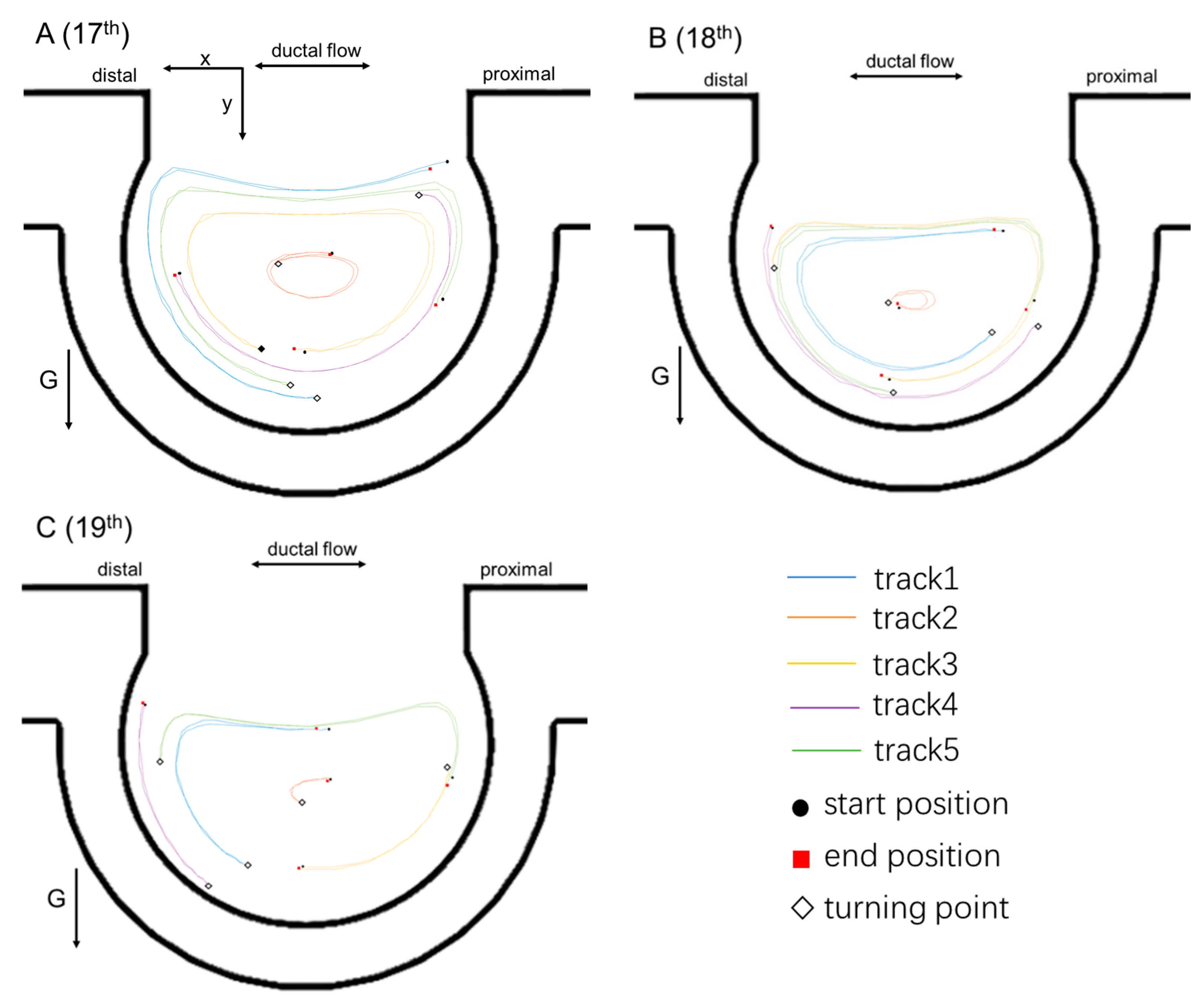
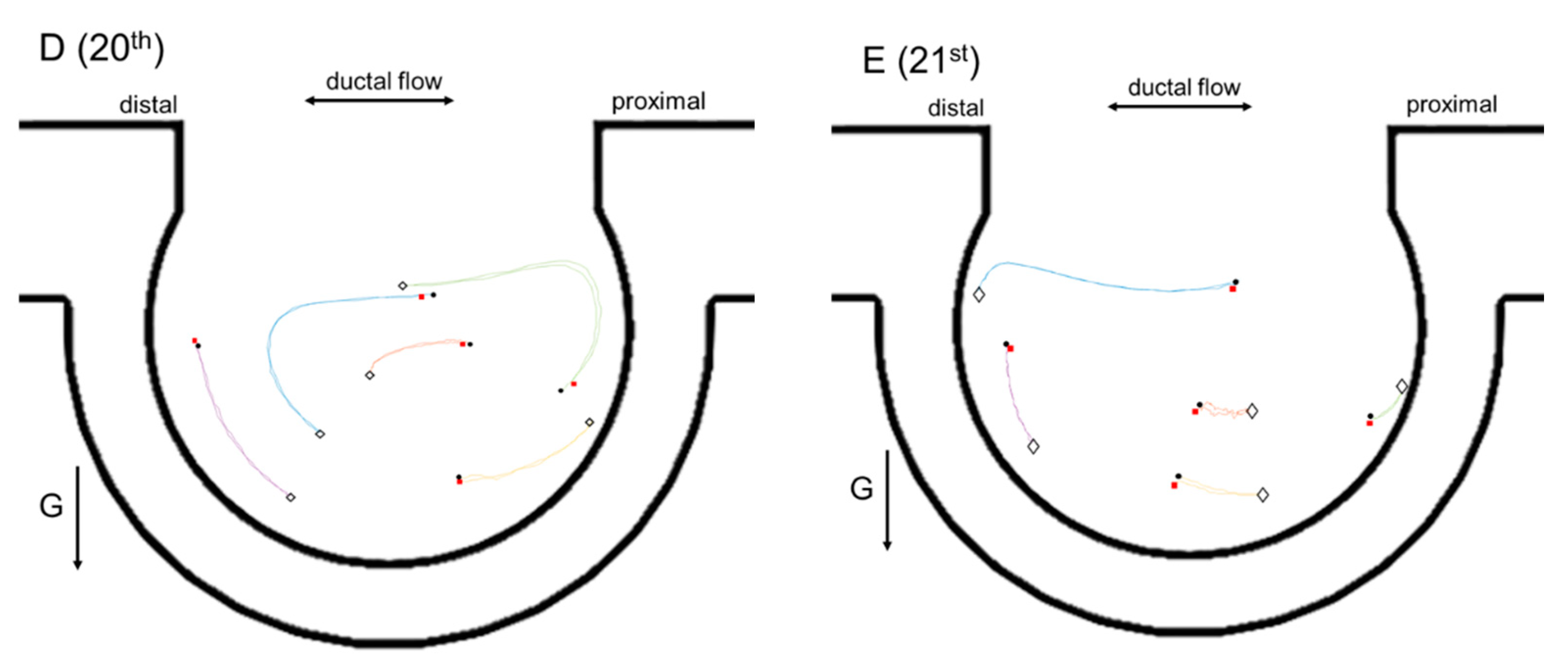
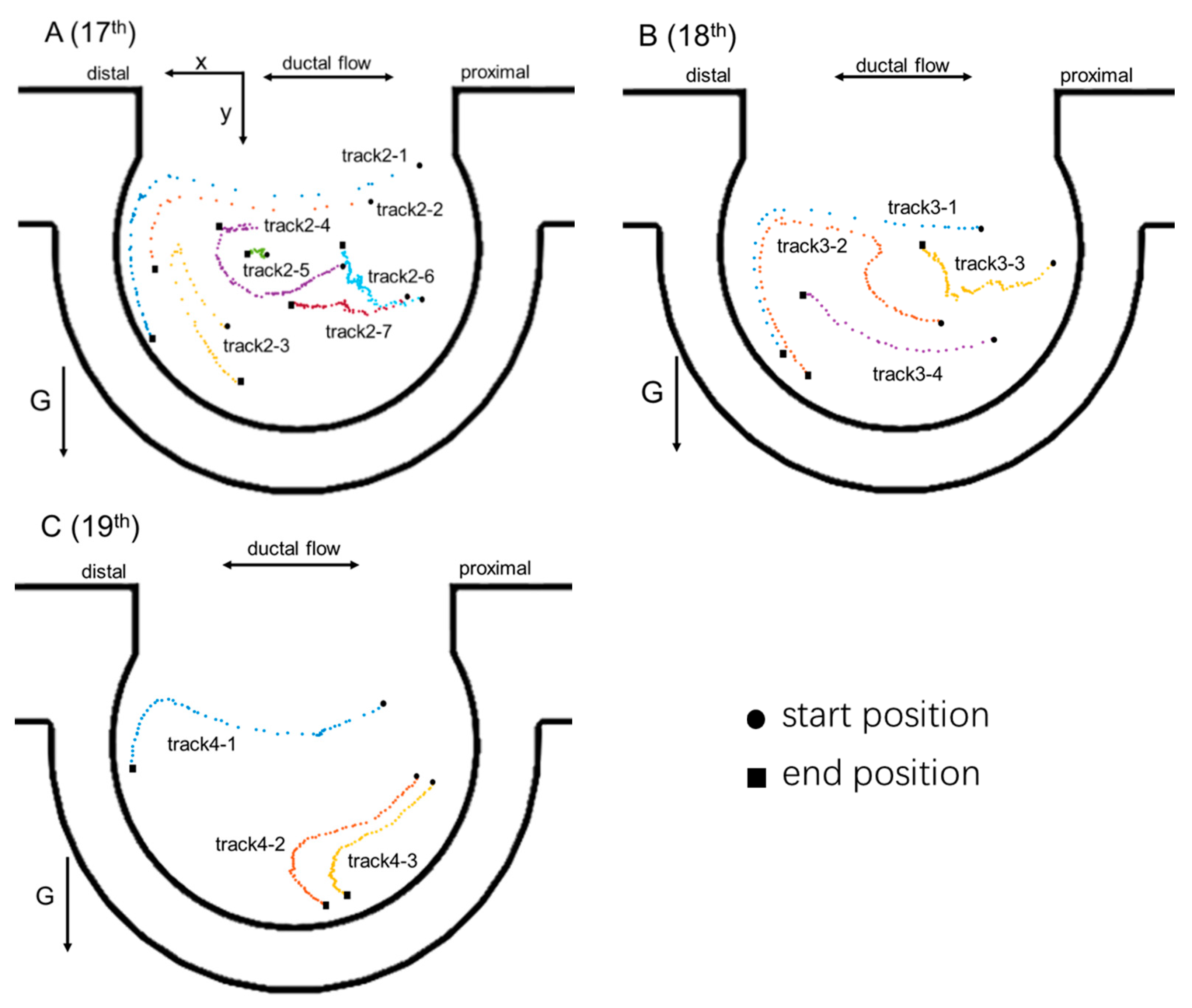
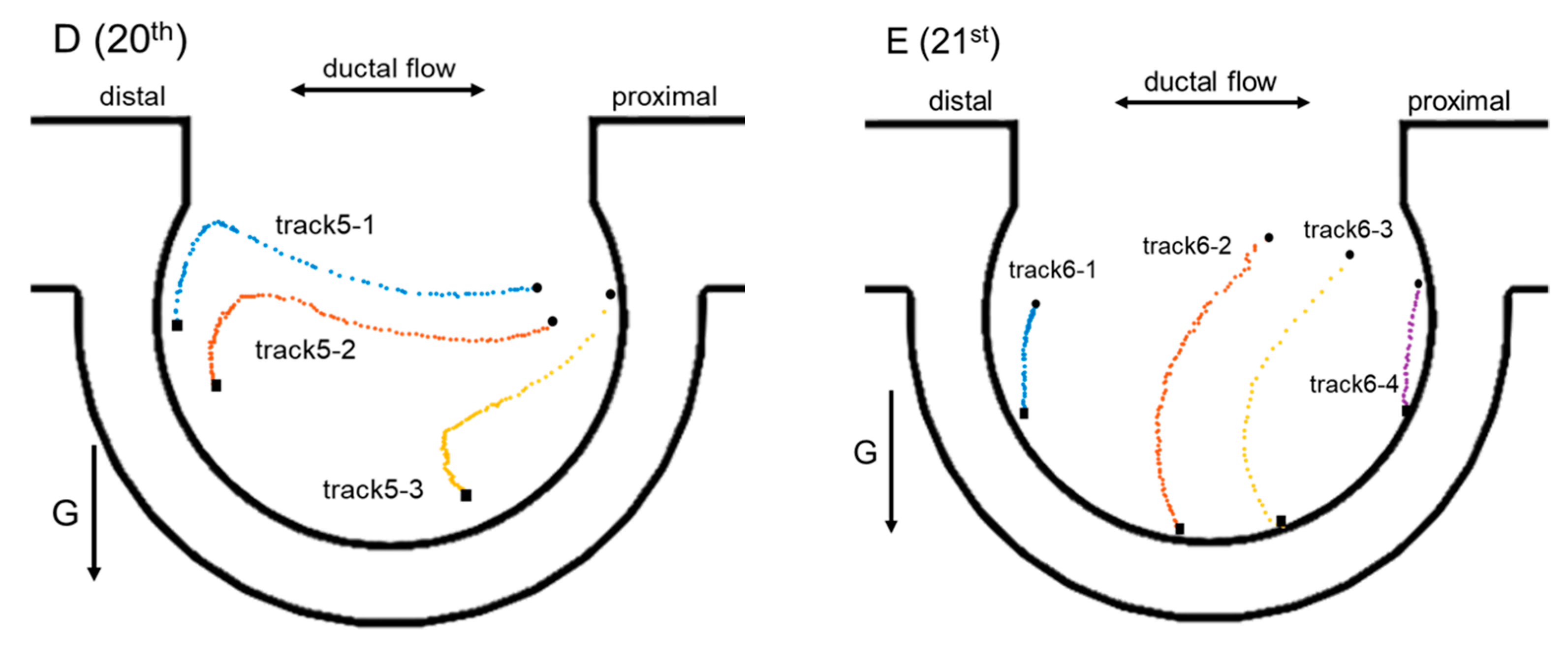
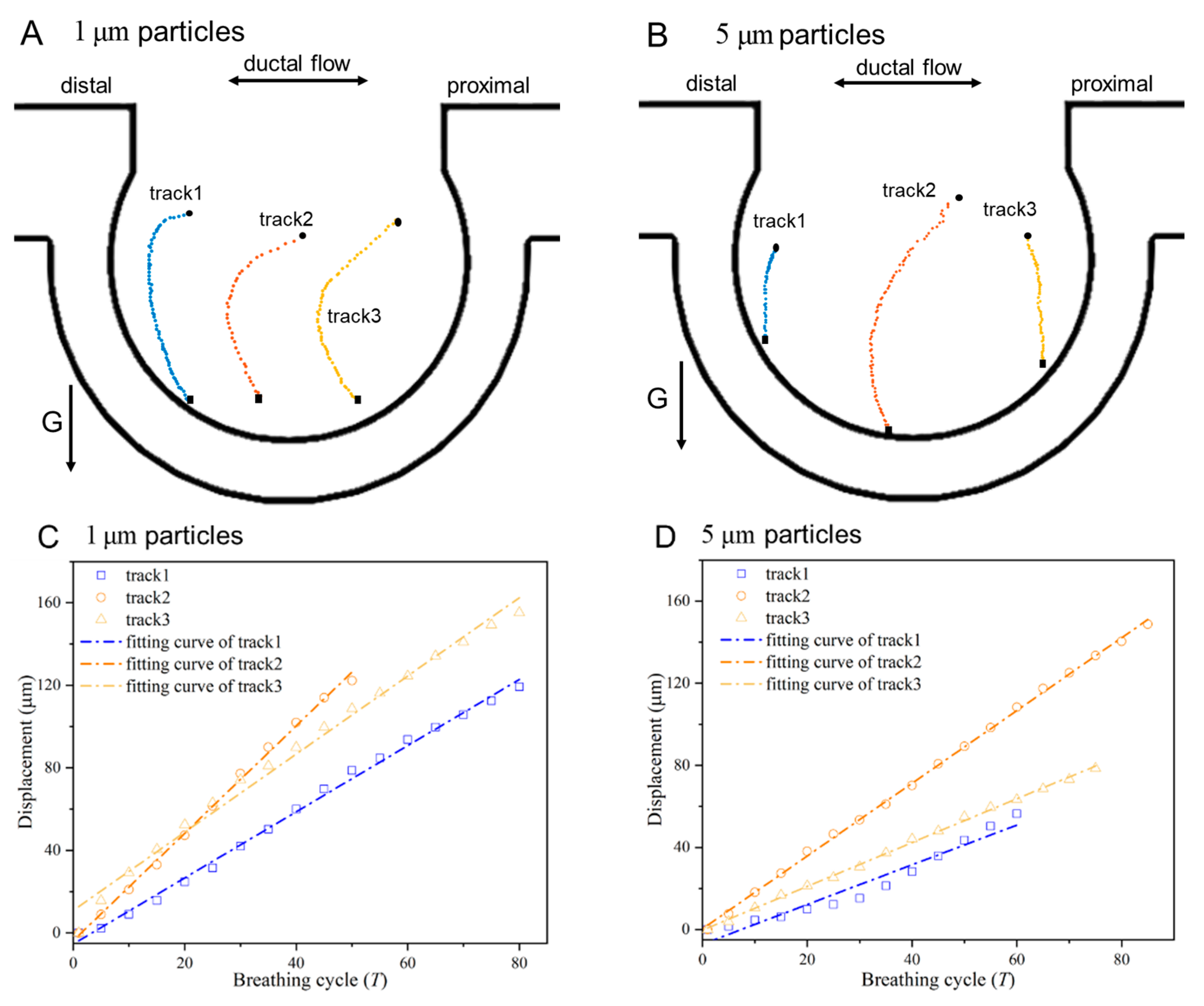
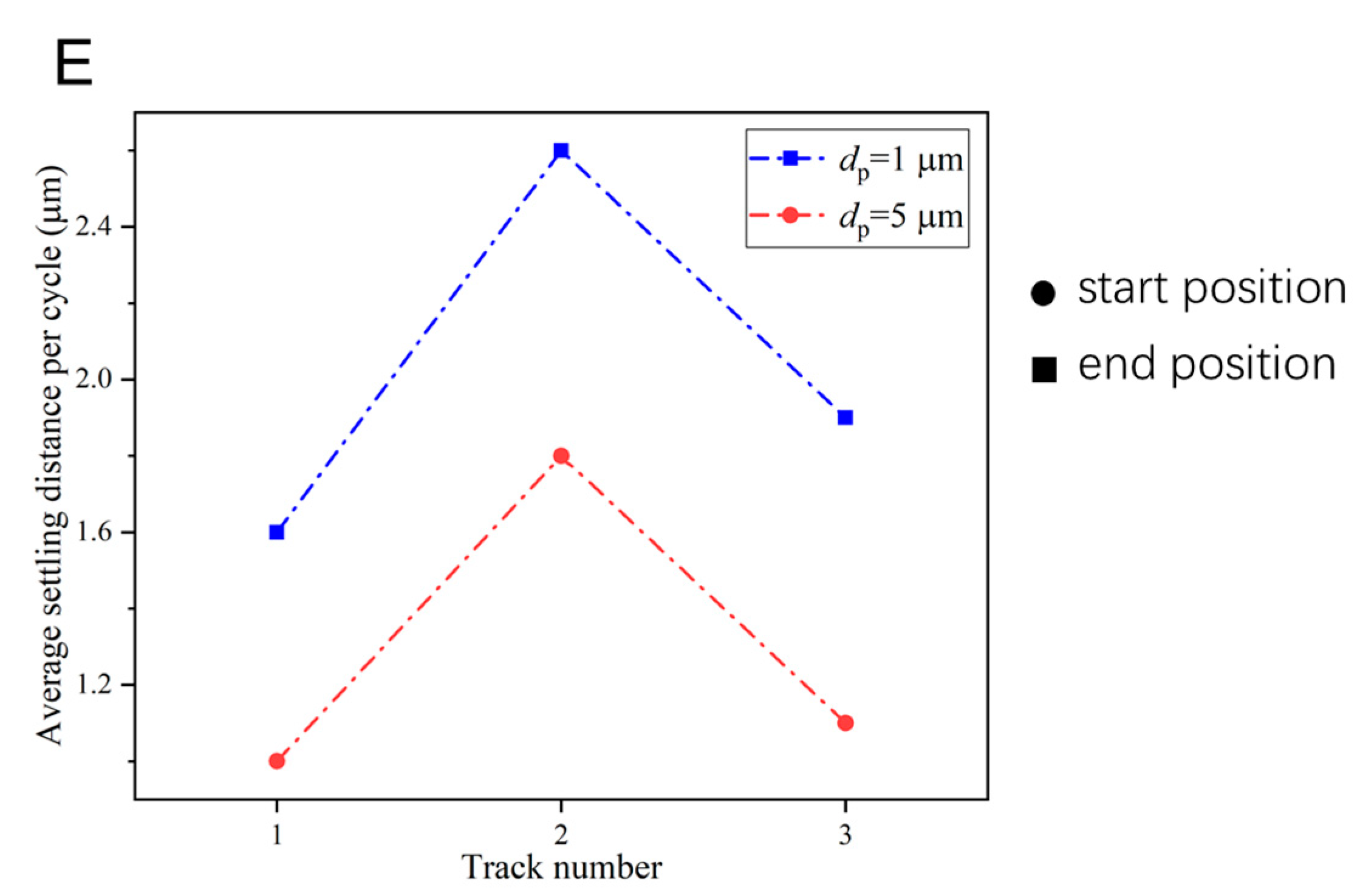
Publisher’s Note: MDPI stays neutral with regard to jurisdictional claims in published maps and institutional affiliations. |
© 2022 by the authors. Licensee MDPI, Basel, Switzerland. This article is an open access article distributed under the terms and conditions of the Creative Commons Attribution (CC BY) license (https://creativecommons.org/licenses/by/4.0/).
Share and Cite
Zhang, W.; Dong, J.; Lv, H.; Bai, W.; Lu, H.; Noack, B.R.; Zhu, Y.; Yang, Y. Microparticle Transport and Sedimentation in a Rhythmically Expanding Alveolar Chip. Micromachines 2022, 13, 485. https://doi.org/10.3390/mi13030485
Zhang W, Dong J, Lv H, Bai W, Lu H, Noack BR, Zhu Y, Yang Y. Microparticle Transport and Sedimentation in a Rhythmically Expanding Alveolar Chip. Micromachines. 2022; 13(3):485. https://doi.org/10.3390/mi13030485
Chicago/Turabian StyleZhang, Wei, Jun Dong, Huimin Lv, Weitao Bai, Hongzhou Lu, Bernd R. Noack, Yonggang Zhu, and Yue Yang. 2022. "Microparticle Transport and Sedimentation in a Rhythmically Expanding Alveolar Chip" Micromachines 13, no. 3: 485. https://doi.org/10.3390/mi13030485
APA StyleZhang, W., Dong, J., Lv, H., Bai, W., Lu, H., Noack, B. R., Zhu, Y., & Yang, Y. (2022). Microparticle Transport and Sedimentation in a Rhythmically Expanding Alveolar Chip. Micromachines, 13(3), 485. https://doi.org/10.3390/mi13030485







